It is a wonderful coincidence that 'Graziela' should continue flowering for Nina, a kindred spirit.
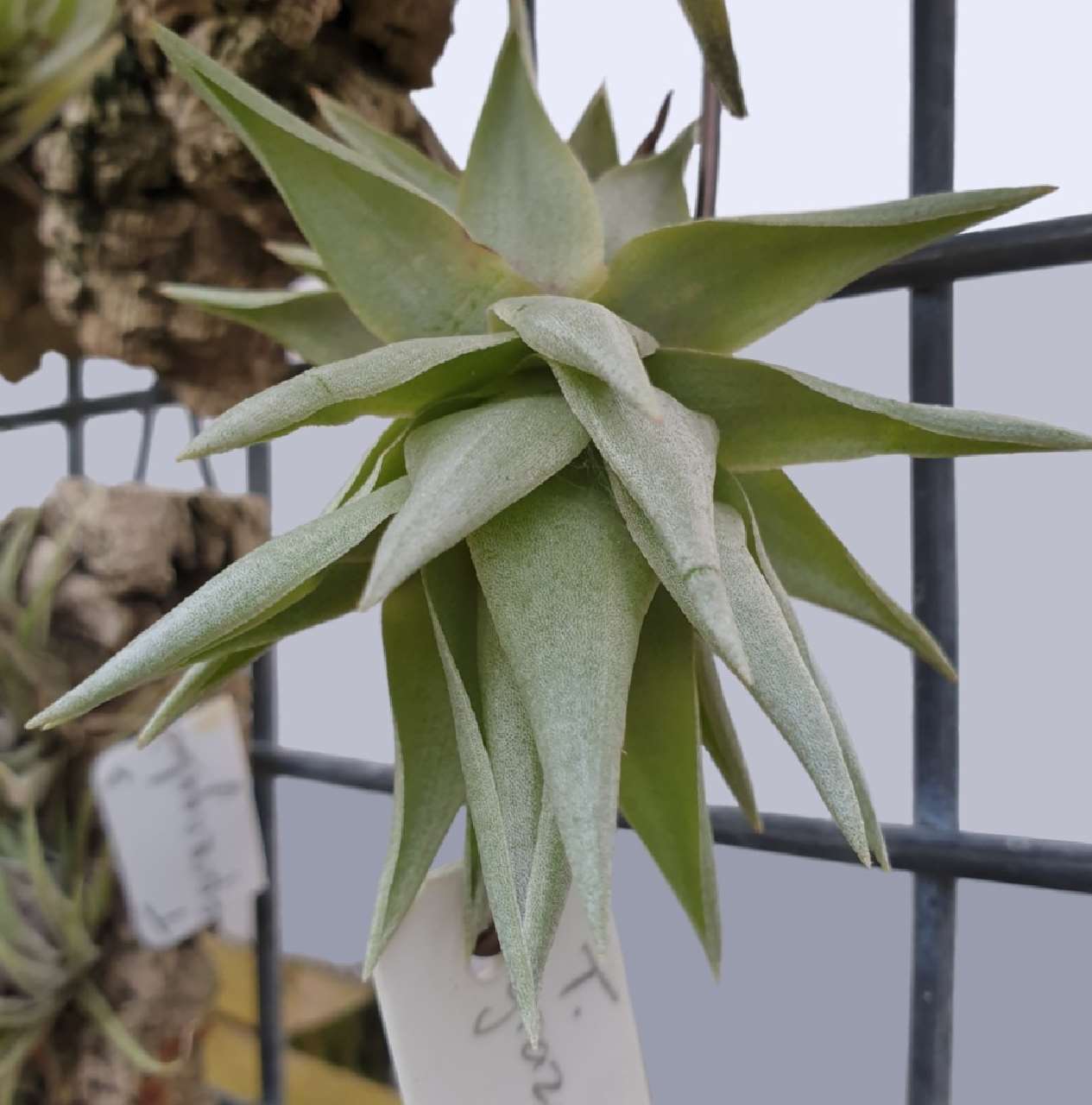
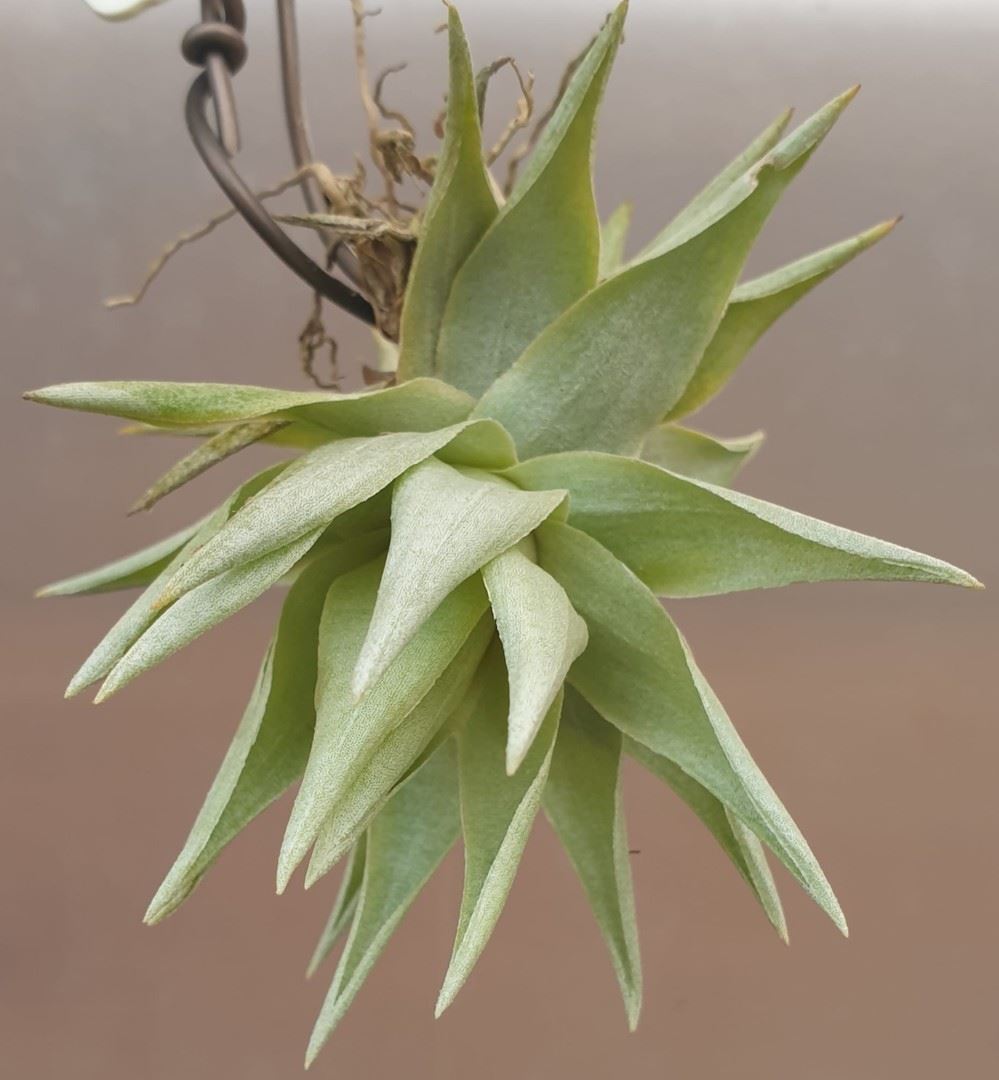
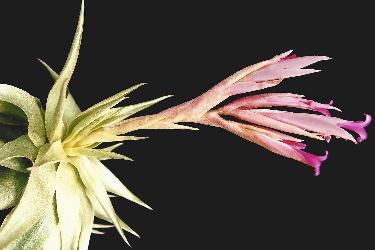
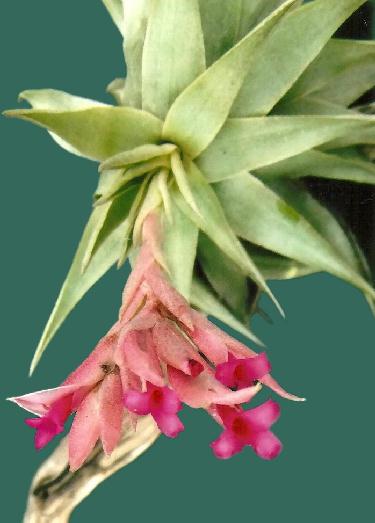
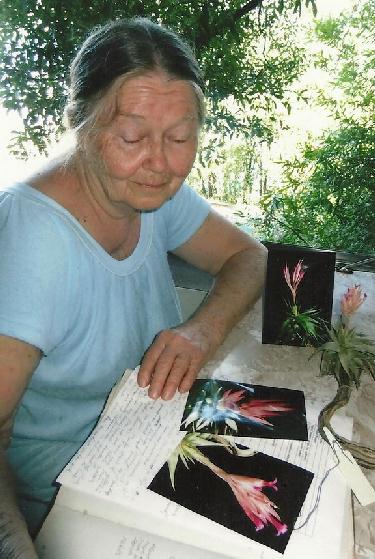
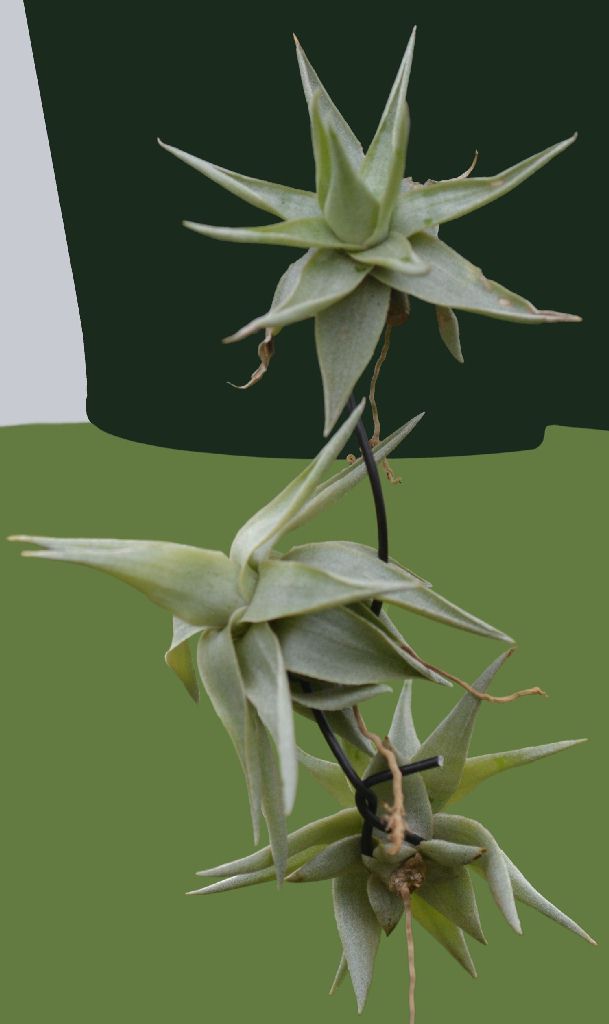
Ed... To find out more about Graziela Barroso, follow the link on FCBS / T. grazielae to a lovely testimonial to her.
It is a wonderful coincidence that 'Graziela' should continue flowering for Nina, a kindred spirit.


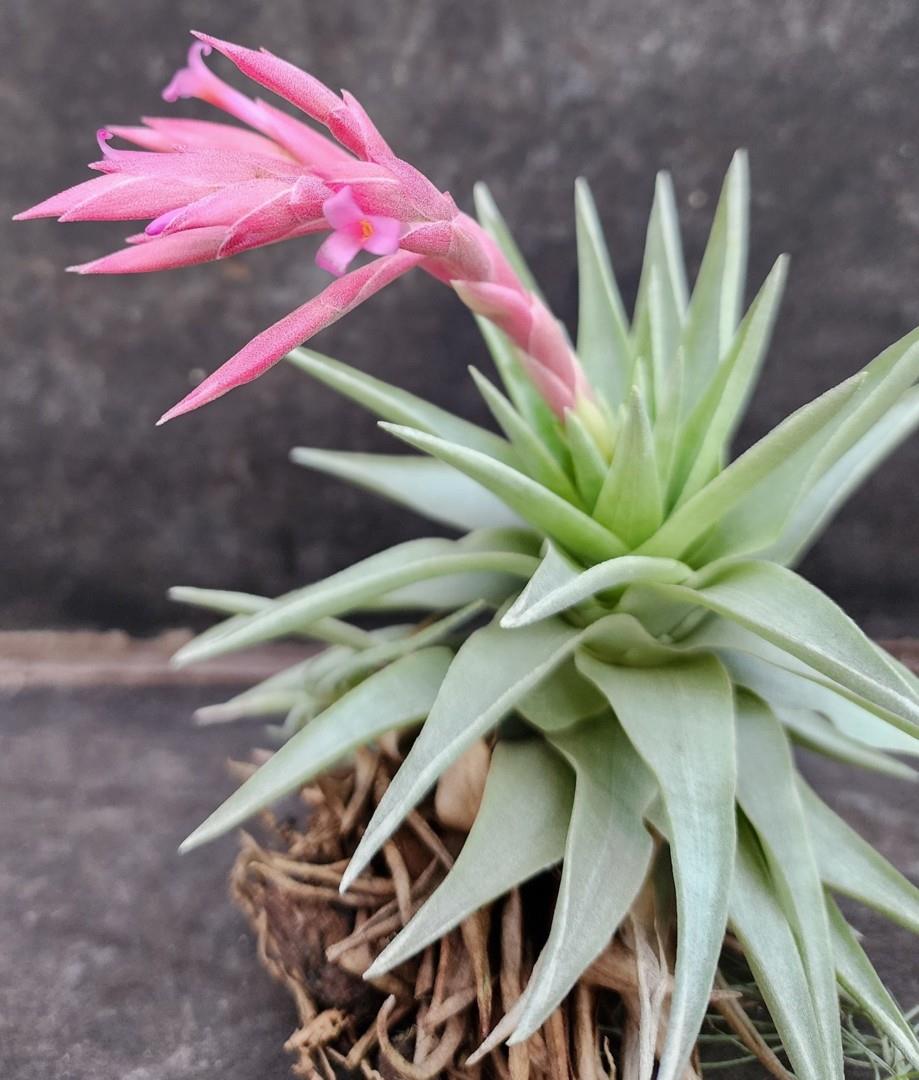
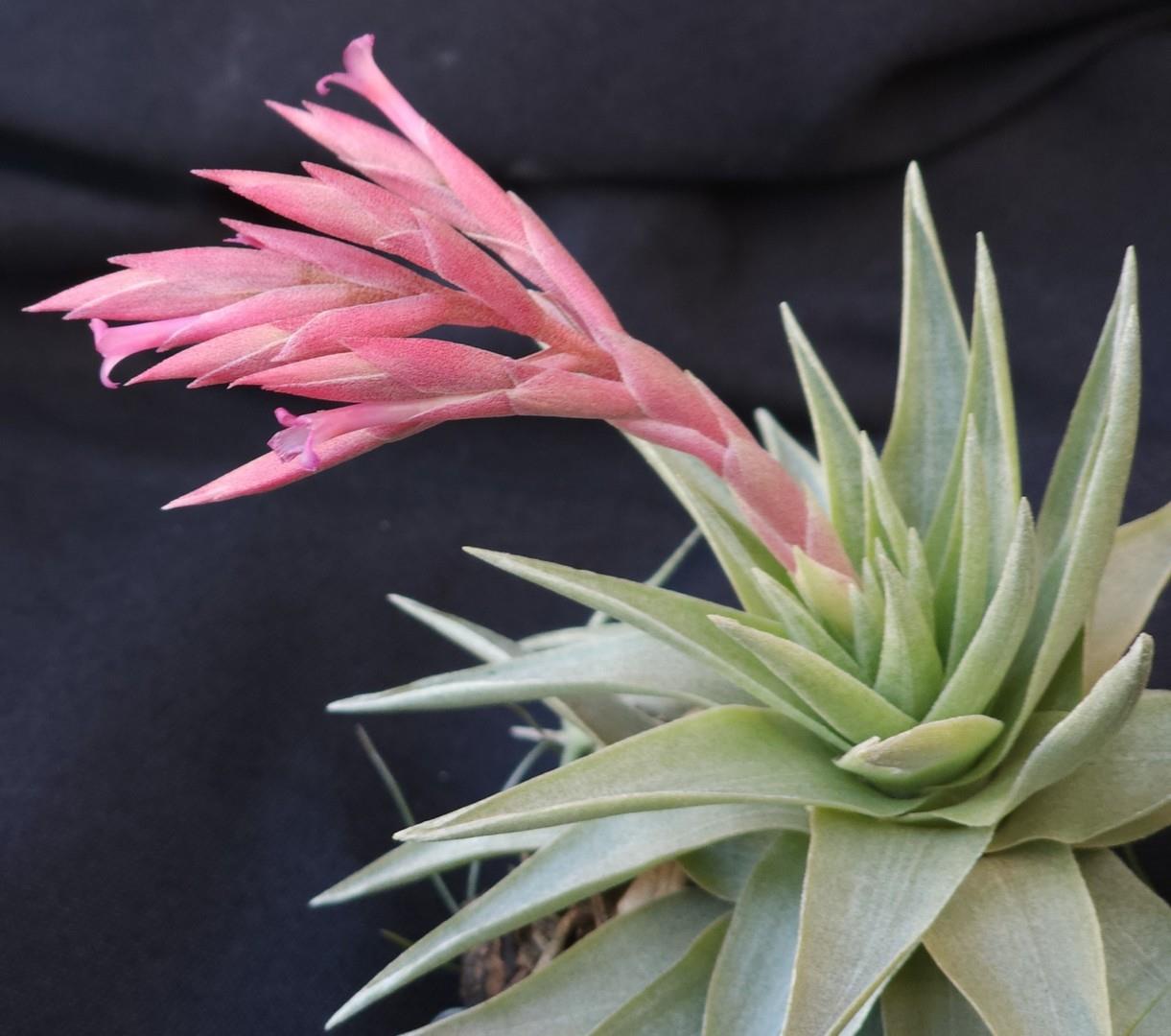
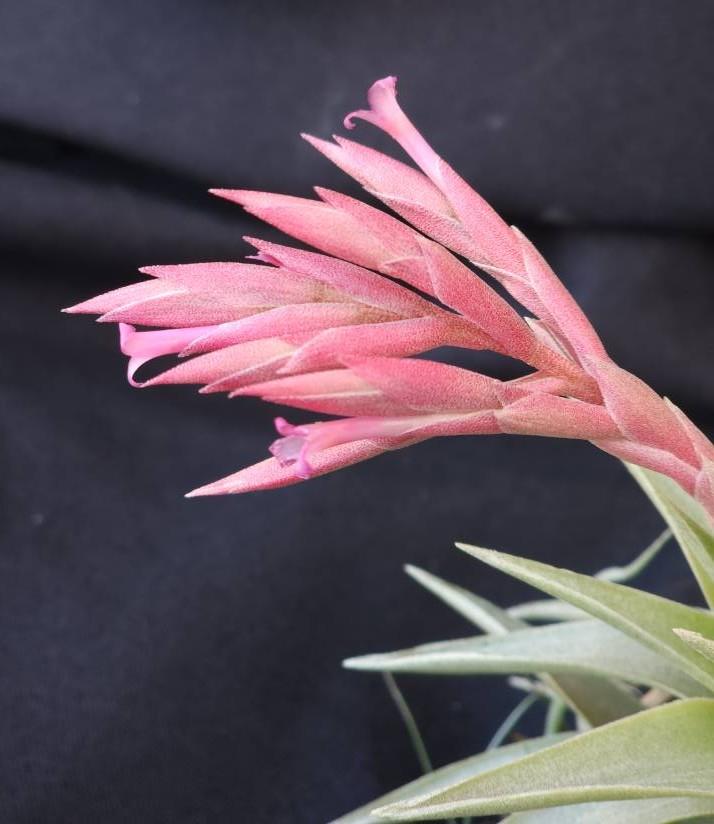
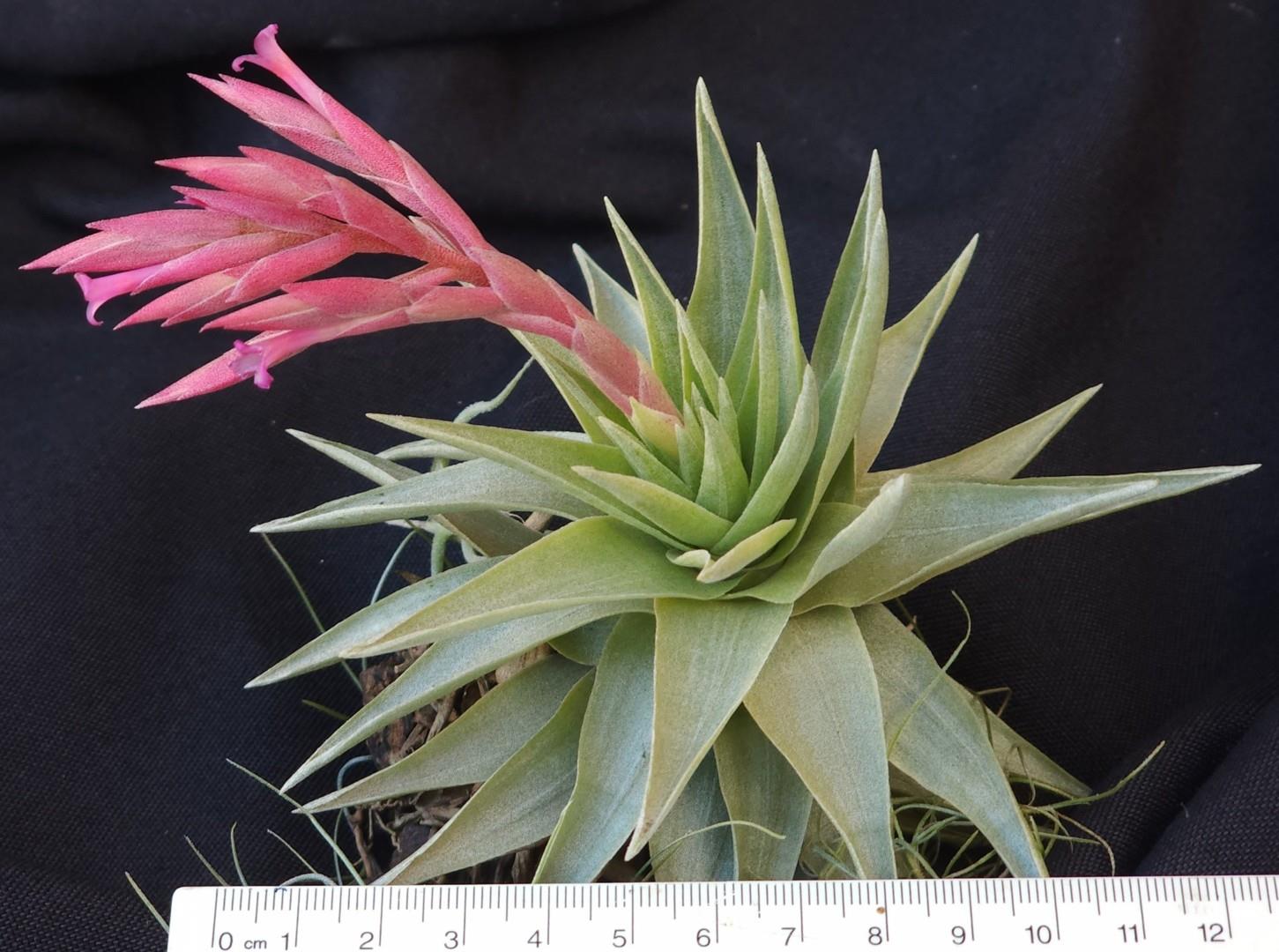
P1ant growing on rocks, stemless, with branched roots and short, thick, brown rhizome at the base, densely enveloped by the dead leaves, forming a dense broad star shaped rosette, 11-13.5cm in diameter.
Leaves flat, almost soft and thin, appearing silvery green or silvery yellow by means of dense appressed scales.
Sheath 2-3cm long, 1.5-1.8cm wide, succulent, indistinct.
Blade 6-8cm long, 1.5cm wide, triangular acute, the tip channeled, almost flat, same colour as the sheath, appressed lepidote.
Scape 5-7cm long, much exceeding the rosette, covered with imbricate scape bracts, the bottom ones subfoliate, up to 4.6cm long, the upper ones about 2.5cm long, shorter, oval, acute or mucronate, the back side pink lepidote.
Inflorescence 6-7.5cm long, bipinnate with 3-9 almost erect spikes.
Primary bracts similar to the upper scape bracts and half as long as the spikes.
Spikes 3-4cm long, 8-10mm wide, lanceolate, complanate, short stipitate, with 3-5 almost sessile distichous flowers.
Floral bracts densely imbricate, rhachis not visible at anthesis. 1.8-2.1cm long, 8mm wide, oval, acute, carinate, outside red, fine appressed scales.
Sepals 1.3-1.4cm long, 5mm wide, lanceolate, acute, sub free, the posterior pair carinate.
Petals 2.3-2.6cm long, 2.5-3mm wide tapering to 2mm at base, narrow lanceolate, forming an erect tube with an open throat, the rounded tip spreading, upper part lilac-pink, the bottom white.
Stamens enclosed.
Filaments 1.5cm long, thin ribbon like, straight, white.
Anther 2mm long, 0.3mm wide, linear, fixed at the base, light brown.
Pollen yellow.
Style 1cm long, white, 0.5mm wide.
Stigma small, hardly wider than the style, lobes erect, white.
Ovary 2.2-2.5mm high, 2mm wide, rounded oval, light green.
Type Brazil, State of Rio de Janeiro near Petropolis.
Named after the Botanist Dr. Graziela M. Barroso.
Comments: This unusual small Tillandsia grows on a huge rock directly above a main highway near Petropolis. The rock face is full of these plants however they are too high to reach for the normal collector. To reach the plants professional contractors have to take extra special efforts. Some years ago a team with a helicopter had a severe accident. A windgust hurled the heli to the rockwall resulting in a crash. A large number of these plants appeared on the German market some years ago coming via an orchid collector. An orchid company had hired an alpinist to collect these plants. However this rock is within a Nature Reservation in Brazil. Hopefully these plants will be preserved by the judicious use of reliable licensing.
TILLANDSIA GRAZIELAE (Bromeliacese) - Especie nova do Estado do Rio de Janeiro.
by Dimitri Sucre B. & Ruby Braga in Bol. Mus. Bot. Mun. Curitiba 22:1. 1975
Planta rupicola, acaulis, radicibus sinuosis, lignosis et brevis. Folia rosulata, densa et patentia, 11-13.5cm diam.; vagina alba, glabra, carnosa, semi-lunata, 3mm longa, 17mm lata; lamina plana, subcarinata, lati-triangularis, parte superiore acuta, canaliculata et apice (3mm longo) cylindrico, 6-8cm longa et 1.5cm lata, herbacea, concolor, viridiargentea, utrimque dense adpresso-lepidota. Inflorescentia composita, rigida, suberecta vel curvata, 7.5-10.5cm longa; scapo 5-7cm longo, bracteis imbricatis; bracteis inferioribus subovatis vel triangularibus, subcarinatis, canaliculatis, apice tereti et acuto, dense adpresso-lepidoto, 4.1-4.6cm lon¬gis, 5-6mm latis; bracteis superioribus ovalibus, apice abrupte acuto et mucronata, ecarinatis, pagina dorsali rosea et dense adpresso-lepidota, 23-25mm longis, 9mm latis; primariis bracteis ovalibus, subacutis, mucronatis, ecarinatis, paginna dorsali rosea et dense adpresso-lepidota, 23-25mm longis, 9mm latis; bracteis florigeris imbricatis, integris et valde carinatis, latiovalibus, apice acuto et dense adpresso-lepidoto in pagina dorsali, 19-21mm longis et 8mm latis. Rachis plerumque 5-ramosa; floribus subsessilibus, 23mm longis; sepalis liberis, aequalibus, subcarinatis, ovato-triangularibus, basi acuta et incrassata, apice acuto et mucronato, glabro, roseo, 13.5mm longis, 5mm latis; petalis lanceolato-spathulatis, apice suberecto, subacuto et leviter incurvato; staminibus inclusis; filamentis linearibus, apice acuto, 8mm longis; antheris dorsifixis, linear-ellipticis, apice curvo, mucronato et basi inaequaliter sagittata, filamentis supra basin insertis; ovario supero, 2.2mm longo; stylo incluso, basi crassa, apicem versus angustato, trifido, 6mm longo.
Holotypus - Brasil: Estado do Rio de Janeiro - Estrada do contorno de Petropolis, 27-1-1968, leg. D, Sucre 2278 et P. I. S. Braga 136 (RB).
T. grazielae apresenta certa afinidade com T. didisticha (E. Morr.) Baker, na morfologia floral.
Entretanto, diverge inteiramente quanto a disposicao dos ramos da inflorescencia (polistica-) com flores de petalas roseas, pelo porte mais delicado, folhas suberbaceas e planas mas cilindricas no apice pelo concrescimento de suas margens.
Esta especie foi encontrada habitando em paredao de rocha nua ensolarada. Os especimes apresentam-se geralmente isolados e esparsos em agrupamentos extensos.
O noma da especie e uma homenagem a eminente botanica Dra. Graziela Maciel Barroso, nossa mestre e amiga.
TILLANDSIA PLANORBIS Reitz, Sellowia 26: 63-7. 1975. Treated as a synonym of T. grazielae by Pereira in Bradea 2:252. 1978
Subgenus Allardtia
RUPICOLA acaulis, vel brevissime caulescens, usque ad 14 cm alta. FOLIA fere plane rosulata (unde nomen "planorbis”), membranaceo.charta¬cea, bene longitudinaliter 3-nervata 4-8cm longa 1.5-2cm lata pauce sub media parte, a basi ovalia ad apicam sensim acuta, fere plana sed versus apicem canaliculato-concava, viride-cinera, ubique bene lepidoto-pruinosa.
INFLORESCENTIA quaquaverse 3-7-ramosa, laxe 2-binnatim panniculata, 8-20-flora, folia duplo superans, ad 10-12cm longa, 3-5cm lata; BRACTEIS PRIMARIIS roseis vaginibus scapalibus isomorphis, extus bene intusque pauce lepidotis, quam spicae permulto brevioribus, bracteis florigeris etiam isomorphis; SPICIS distiche-florigeris, subpatente-adscendentibus, 2 - 4-floris, 4-5cm longis; BRACTEIS FLORIGERIS roseis, basali saepe sterili, ample ovato-acutis, versus apicem subcarinatis, extus optime lepidotis, intus glabris, distiche dispositis, 21mm longis, 10mm latis, ad 4mm sepalis maioribus, per anthesim nullo modo imbricatis. FLORES 25mm longi, in ramulis distiche dispositis; SEPALIS roseo-coloratis, symmetricis, duo ad 0.5mm connatis, tertia altius ad 1.5mm connata, 12mm longis, 5mm latis, ovato-lanceolatis, apice acutis; PETALIS liberis, roseo-violaceis, vix linearibus, 20-22mm longis, ad 3mm latis fere tota longitudine, apice obtusis recurvatisque, stamina profunde in fauce exibentibus, ca. 8mm sepalis longioribus; STAMINIBUS 16mm longis, petalis brevioribus, stylo subaequalibus, filamentis tenerrimis, albis, antheris flavis, 2mm longis, ad basim dorsifixis; STYLO staminibus subaequale, albo, ad apicem roseo, stygmatibus tribus luteis; OVARIO ovali, 4mm longo, 1.5mm lato, fertili fere usque ad apicem vix subito in stylum rectum exeunte; PLACENTIS interne loculorum angulo a basi usque supra medium lineariter affixis; OVULIS paucis, cylindraceis, ad apicem super quoddam collum capitatis, ecaudatis; CAPSULA 22mm longa, 3mm lata, subcylindrico-striata, asice mucronata, ad mediam partem sepalis vestita; exocarpo viride-atro. Holotypus - BRASIL: Rio da Cidade, KM 57 da BR 135 (Estrada do Contorno), pouco a leste da entrada para Araras, em enorme rochiedo densamente so coberto com esta Tillandsia, Petropolis, Estado do Rio de Janeiro, rupicola, ut videtur endemica, 750m de altit., P. R. Reitz 7788 (20.03.1975), HBR. Ibidem, fruto, P. R. Reitz 7675 (30.7.1974), HBR; ibidem P. R. Reitz 7807 (15.04.1975), HBR.
Key to Brazilian Tillandsias, with red or pink petals from Die Bromelie, Sonderheft 3 1996
1. Stamens - exceeding the flower tube => paraensis
- included in the flower tube => 2
2. Leaf blade - filiform and grasslike => globosa
- triangular => 3
3. Plant - 4 - 8 cm in diameter => 8
- 10 - 25 cm in diameter, forming a more or less spreading rosette, stemless => 4
4. Floral bracts - lepidote => 5
- glabrous or nearly so: Plant 6 - 15 cm diameter, inflorescence elliptic or globose, spikes elliptic, sublax with 1 - 3 (- 5) flowers, floral bracts carinate, glabrous or punctulate lepidote, sepals glabrous => roseiflora
5. Inflorescence - elliptic or subglobose => 6
- elongate => 7
6. Leaves - soft, green or reddish, appressed lepidote, spike lax, 2 - 4 flowered, floral bracts shorter than sepals, petals red - violet => geminiflora
- soft, grey, densely lepidote with spreading trichomes, spikes dense, 3 - 12 flowered, floral bracts densely lepidote, exceeding the lepidote sepals => gardneri
7. Leaves - subsucculent, stiff, inflorescence with 4 - 6 spikes => chapeuensis
- Plant only 11 - 13 cm in diameter, an open silvery star-shaped rosette, leaves appressed lepidote, inflorescence with 5 - 7 spikes => grazielae
8. Plant - short - caulescent => 9
- stemless, forming an erect, often subbulbose rosette, leaves often somewhat secund, inflorescence elliptic or subglobose, flowers red or violet, filament not plicate => 10
9. Plant - 3 to 5 cm in diameter, pine cone shaped, dorsiventral, pendant, leaves green, silvery appressed lepidote, inflorescence simple, distichous => reclinata
- 4 to 8 cm in diameter, an erect-secund rosette, the basal leaves recurved, leaves cinereous-lepidote, inflorescence compound, spikes lax, floral bracts carinate, shorter than the lepidote sepals, the posterior ones carinate and 4 mm connate => sucrei
10. Floral bracts - glabrous or nearly so => 14
- lepidote => 11
11. Inflorescence - simple => 12
- bipinnate: Leaves channelled, regularly lepidote with coarse cinereous scales, inflorescence with up to 8 spikes which are laxly 3 - 4 flowered, the posterior sepals carinate, 1/3 to 1/2 connate, lithophytic growing at sea level => brachyphylla
12. Inflorescence - with polystichous flowers => 13
- with distichous flowers: Plant ca. 4 cm in diameter, short caulescent, small pine cone shaped, pendant, leaves grey appressed lepidote => reclinata
13. Leaves - secund, thin and soft, grey with appressed trichomes, looking like grey velvet, scape densely lepidote, inflorescence simple, sometimes compound of up to 3-flowered spikes, floral bracts carmine-red, sepals slightly lepidote, free, posterior ones carinate, petals violet-rose => heubergeri
- Leaves not secund, subsucculent, green, covered with coarse grey scales, plant pendant, floral bracts rose, sepals more lepidote, petals pink => thiekenii
14. Posterior sepals - not carinate => 15
- carinate => 16
15. Leaves many, green-grey, densely lepidote with irregular cumulated coarse trichomes, appearing rough pruinose, epiphytic at sea level => sprengeliana
- Leaves many, narrow triangular, with appressed trichomes, appearing metallic, epiphytic 700 - 1000 m => kautskyi
16. Plant - 2.5 to 5 cm in diameter, rosette of broadly triangular leaves with shorter blade, very densely and regularly silvery subpruinose lepidote, appearing like silvery velvet, sepals carinate and short connate, lithophytic 1800 - 2200 m => organensis
- Plant bigger, up to 15 cm in diameter, rosette often bulbose, leaves grey - green appressed grey lepidote, appearing like grey velvet, bipinnate with 1 - 3 (-5 ) flowered spikes, floral bracts conspicuously carinate, posterior sepals carinate, epiphytic => roseiflora